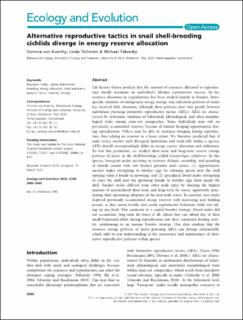Please use this identifier to cite or link to this item:
https://doi.org/10.21256/zhaw-2017Full metadata record
| DC Field | Value | Language |
|---|---|---|
| dc.contributor.author | von Kuerthy, Corinna | - |
| dc.contributor.author | Tschirren, Linda | - |
| dc.contributor.author | Taborsky, Michael | - |
| dc.date.accessioned | 2018-07-05T14:01:37Z | - |
| dc.date.available | 2018-07-05T14:01:37Z | - |
| dc.date.issued | 2015 | - |
| dc.identifier.issn | 2045-7758 | de_CH |
| dc.identifier.uri | https://digitalcollection.zhaw.ch/handle/11475/7603 | - |
| dc.description.abstract | Life history theory predicts that the amount of resources allocated to reproduction should maximize an individual's lifetime reproductive success. So far, resource allocation in reproduction has been studied mainly in females. Intraspecific variation of endogenous energy storage and utilization patterns of males has received little attention, although these patterns may vary greatly between individuals pursuing alternative reproductive tactics (ARTs). ARTs are characterized by systematic variation of behavioral, physiological, and often morphological traits among same-sex conspecifics. Some individuals may rely on previously accumulated reserves, because of limited foraging opportunities during reproduction. Others may be able to continue foraging during reproduction, thus relying on reserves to a lesser extent. We therefore predicted that, if male tactics involve such divergent limitations and trade-offs within a species, ARTs should correspondingly differ in energy reserve allocation and utilization. To test this prediction, we studied short-term and long-term reserve storage patterns of males in the shell-brooding cichlid Lamprologus callipterus. In this species, bourgeois males investing in territory defense, courtship, and guarding of broods coexist with two distinct parasitic male tactics: (1) opportunistic sneaker males attempting to fertilize eggs by releasing sperm into the shell opening when a female is spawning; and (2) specialized dwarf males attempting to enter the shell past the spawning female to fertilize eggs from inside the shell. Sneaker males differed from other male types by showing the highest amount of accumulated short-term and long-term fat stores, apparently anticipating their upcoming adoption of the nest male status. In contrast, nest males depleted previously accumulated energy reserves with increasing nest holding period, as they invest heavily into costly reproductive behaviors while not taking up any food. This conforms to a capital breeder strategy. Dwarf males did not accumulate long-term fat stores at all, which they can afford due to their small behavioral effort during reproduction and their continued feeding activity, conforming to an income breeder strategy. Our data confirm that the resource storage patterns of males pursuing ARTs can diverge substantially, which adds to our understanding of the coexistence and maintenance of alternative reproductive patterns within species. | de_CH |
| dc.language.iso | en | de_CH |
| dc.publisher | Wiley | de_CH |
| dc.relation.ispartof | Ecology and Evolution | de_CH |
| dc.rights | https://creativecommons.org/licenses/by/4.0/ | de_CH |
| dc.subject | Bourgeois males | de_CH |
| dc.subject | Capital breeding | de_CH |
| dc.subject | Energy allocation | de_CH |
| dc.subject | Fixed parasitic tactics | de_CH |
| dc.subject | Reserves | de_CH |
| dc.subject | Storage | de_CH |
| dc.subject | Income breeding | de_CH |
| dc.subject | Plastic parasitic tactics | de_CH |
| dc.subject.ddc | 577: Ökologie | de_CH |
| dc.subject.ddc | 590: Tiere (Zoologie) | de_CH |
| dc.title | Alternative reproductive tactics in snail shell-brooding cichlids diverge in energy reserve allocation | de_CH |
| dc.type | Beitrag in wissenschaftlicher Zeitschrift | de_CH |
| dcterms.type | Text | de_CH |
| zhaw.departement | Life Sciences und Facility Management | de_CH |
| zhaw.organisationalunit | Institut für Umwelt und Natürliche Ressourcen (IUNR) | de_CH |
| dc.identifier.doi | 10.21256/zhaw-2017 | - |
| dc.identifier.doi | 10.1002/ece3.1495 | de_CH |
| dc.identifier.pmid | 26045956 | de_CH |
| zhaw.funding.eu | No | de_CH |
| zhaw.issue | 10 | de_CH |
| zhaw.originated.zhaw | No | de_CH |
| zhaw.pages.end | 2069 | de_CH |
| zhaw.pages.start | 2060 | de_CH |
| zhaw.publication.status | publishedVersion | de_CH |
| zhaw.volume | 5 | de_CH |
| zhaw.publication.review | Peer review (Publikation) | de_CH |
| zhaw.webfeed | Aquakultur-Systeme | de_CH |
| Appears in collections: | Publikationen Life Sciences und Facility Management | |
Files in This Item:
| File | Description | Size | Format | |
|---|---|---|---|---|
| 2015_Tschirren_Alternative_reprodctive_tactics.pdf | 377.18 kB | Adobe PDF |  View/Open |
Show simple item record
von Kuerthy, C., Tschirren, L., & Taborsky, M. (2015). Alternative reproductive tactics in snail shell-brooding cichlids diverge in energy reserve allocation. Ecology and Evolution, 5(10), 2060–2069. https://doi.org/10.21256/zhaw-2017
von Kuerthy, C., Tschirren, L. and Taborsky, M. (2015) ‘Alternative reproductive tactics in snail shell-brooding cichlids diverge in energy reserve allocation’, Ecology and Evolution, 5(10), pp. 2060–2069. Available at: https://doi.org/10.21256/zhaw-2017.
C. von Kuerthy, L. Tschirren, and M. Taborsky, “Alternative reproductive tactics in snail shell-brooding cichlids diverge in energy reserve allocation,” Ecology and Evolution, vol. 5, no. 10, pp. 2060–2069, 2015, doi: 10.21256/zhaw-2017.
VON KUERTHY, Corinna, Linda TSCHIRREN und Michael TABORSKY, 2015. Alternative reproductive tactics in snail shell-brooding cichlids diverge in energy reserve allocation. Ecology and Evolution. 2015. Bd. 5, Nr. 10, S. 2060–2069. DOI 10.21256/zhaw-2017
von Kuerthy, Corinna, Linda Tschirren, and Michael Taborsky. 2015. “Alternative Reproductive Tactics in Snail Shell-Brooding Cichlids Diverge in Energy Reserve Allocation.” Ecology and Evolution 5 (10): 2060–69. https://doi.org/10.21256/zhaw-2017.
von Kuerthy, Corinna, et al. “Alternative Reproductive Tactics in Snail Shell-Brooding Cichlids Diverge in Energy Reserve Allocation.” Ecology and Evolution, vol. 5, no. 10, 2015, pp. 2060–69, https://doi.org/10.21256/zhaw-2017.
Items in DSpace are protected by copyright, with all rights reserved, unless otherwise indicated.